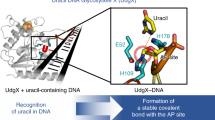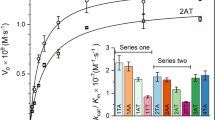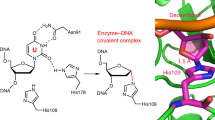Abstract
In humans, uracil appears in DNA at the rate of several hundred bases per cell each day as a result of misincorporation of deoxyuridine (dU) or deamination of cytosine. Four enzymes that catalyse the hydrolysis of the glycosylic bond of dU in DNA to yield an apyridiminic site as the first step in base excision repair have been identified in the human genome1. The most efficient and well characterized of these uracil-DNA glycosylases is UDG (also known as UNG and present in almost all known organisms)2, which excises U from single- or double-stranded DNA and is associated with DNA replication forks3. We used a hybrid quantum-mechanical/molecular-mechanical (QM/MM) approach4 to determine the mechanism of catalysis by UDG. In contrast to the concerted associative mechanism proposed initially5,6,7,8,9,10, we show here that the reaction proceeds in a stepwise dissociative manner11,12. Cleavage of the glycosylic bond yields an intermediate comprising an oxocarbenium cation and a uracilate anion. Subsequent attack by a water molecule and transfer of a proton to D145 result in the products. Surprisingly, the primary contribution to lowering the activation energy comes from the substrate, rather than from the enzyme. This ‘autocatalysis’ derives from the burial and positioning of four phosphate groups that stabilize the rate-determining transition state. The importance of these phosphates explains the residual activity observed for mutants that lack key residues6,7,8,9. A corresponding catalytic mechanism could apply to the DNA glycosylases TDG and SMUG1, which belong to the same structural superfamily as UDG13,14.
This is a preview of subscription content, access via your institution
Access options
Subscribe to this journal
Receive 51 print issues and online access
$199.00 per year
only $3.90 per issue
Buy this article
- Purchase on Springer Link
- Instant access to full article PDF
Prices may be subject to local taxes which are calculated during checkout



Similar content being viewed by others
References
Wood, R. D., Mitchell, M., Sgouros, J. & Lindahl, T. Human DNA repair genes. Science 291, 1284–1289 (2001).
Mol, C. D., Parikh, S. S., Putnam, C. D., Lo, T. P. & Tainer, J. A. DNA repair mechanisms for the recognition and removal of damaged DNA bases. Annu. Rev. Biophys. Biomol. Struct. 28, 101–128 (1999).
Nilsen, H. et al. Uracil-DNA glycosylase (UNG)-deficient mice reveal a primary role of the enzyme during DNA replication. Mol. Cell 5, 1059–1065 (2000).
Field, M. J., Bash, P. A. & Karplus, M. A combined quantum mechanical and molecular mechanical potential for molecular dynamics simulations. J. Comp. Chem. 11, 700–733 (1990).
Savva, R., McAuley-Hecht, K., Brown, T. & Pearl, L. The structural basis of specific base excision repair by uracil-DNA glycosylase. Nature 373, 487–493 (1995).
Slupphaug, G. et al. A nucleotide-flipping mechanism from the structure of human uracil-DNA glycosylase bound to DNA. Nature 384, 87–92 (1996).
Shroyer, M. J. N., Bennett, S. E., Putnam, C. D., Tainer, J. A. & Mosbaugh, D. W. Mutation of an active site residue in Escherichia coli uracil DNA glycosylase: effect on DNA binding, uracil inhibition and catalysis. Biochemistry 38, 4834–4845 (1999).
Drohat, A. C. et al. Heteronuclear NMR and crystallographic studies of wild-type and H187Q Escherichia coli uracil DNA glycosylase: electrophilic catalysis of uracil expulsion by a neutral histidine 187. Biochemistry 38, 11876–11886 (1999).
Drohat, A. C., Jagadeesh, J., Ferguson, E. & Stivers, J. T. Role of electrophilic and general base catalysis in the mechanism of Escherichia coli uracil DNA glycosylase. Biochemistry 38, 11866–11875 (1999).
Drohat, A. C. & Stivers, J. T. NMR evidence for an unusually low N1 pKa for uracil bound to uracil DNA glycosylase: implications for catalysis. J. Am. Chem. Soc. 122, 1840–1841 (2000).
Parikh, S. S. et al. Uracil-DNA glycosylase-DNA substrate and product structures: conformational strain promotes catalytic efficiency by coupled stereoelectronic effects. Proc. Natl Acad. Sci. USA 97, 5083–5088 (2000).
Werner, R. M. & Stivers, J. T. Kinetic isotope effect studies of the reaction catalyzed by uracil DNA glycosylase: evidence for an oxocarbenium-ion anion intermediate. Biochemistry 39, 14054–14064 (2000).
Haushalter, K. A., Stukenberg, P. T., Kirschner, M. W. & Verdine, G. L. Identification of a new uracil-DNA glycosylase family by expression cloning using synthetic inhibitors. Curr. Biol. 9, 174–185 (1999).
Pearl, L. H. Structure and function in the uracil-DNA glycosylase superfamily. Mutat. Res. 460, 165–181 (2000).
Dewar, M. J. S., Zoebisch, E. G., Healy, E. F. & Stewart, J. J. P. AM1: A new general purpose quantum mechanical molecular model. J. Am. Chem. Soc. 107, 3902–3909 (1985).
Brooks, B. R. et al. CHARMM: A program for macromolecular energy, minimization, and dynamics calculations. J. Comp. Chem. 4, 187–217 (1983).
Simonson, T., Archontis, G. & Karplus, M. Continuum treatment of long-range interactions in free energy calculations. Application to protein-ligand binding. J. Phys. Chem. B 101, 8349–8362 (1997).
Slupphaug, G. et al. Properties of a recombinant human uracil-DNA glycosylase from the UNG gene and evidence that UNG encodes the major uracil-DNA glycosylase. Biochemistry 34, 128–138 (1995).
Weinhold, F. in Encyclopedia of Computational Chemistry (ed. Schleyer, P. R.) 1792–1811 (Wiley, New York, 1998).
Chen, X.-Y., Berti, P. J. & Schramm, V. L. Transition-state analysis for depurination of DNA by ricin A-chain. J. Am. Chem. Soc. 122, 6527–6534 (2000).
Bash, P. A. et al. Computer simulation and analysis of the reaction pathway of triosephosphate isomerase. Biochemistry 30, 5826–5832 (1991).
Drohat, A. C. & Stivers, J. T. Escherichia coli uracil DNA glycosylase: NMR characterization of the short hydrogen bond from His187 to uracil O2. Biochemistry 39, 11865–11875 (2000).
Wu, N., Mo, Y., Gao, J. & Pai, E. F. Electrostatic stress in catalysis: structure and mechanism of the enzyme orotodine monophosphate decarboxylase. Proc. Natl Acad. Sci. USA 97, 2017–2022 (2000).
Shapiro, R. & Kang, S. Uncatalyzed hydrolysis of deoxyuridine, thymidine, and 5-bromodeoxyuridine. Biochemistry 8, 1806–1810 (1969).
Schaefer, M., Sommer, M. & Karplus, M. pH-dependence of protein stability: absolute electrostatic free energy differences between conformations. J. Phys. Chem. B 101, 1663–1683 (1997).
MacKerell, A. D. Jr, Wiórkiewicz-Kuczera, J. & Karplus, M. An all-atom empirical energy function for the simulation of nucleic acids. J. Am. Chem. Soc. 117, 11946–11975 (1995).
MacKerell, A. D. Jr et al. All-atom empirical potential for molecular modeling and dynamics studies of proteins. J. Phys. Chem. B 102, 3586–3616 (1998).
Jorgensen, W. L., Chandrasekhar, J., Madura, J. D., Impey, R. W. & Klein, M. L. Comparison of simple potential functions for simulating liquid water. J. Chem. Phys. 79, 926–935 (1983).
Reuter, N., Dejaegere, A., Maigret, B. & Karplus, M. Frontier bonds in QM/MM methods: a comparison of different approaches. J. Phys. Chem. A 104, 1720–1735 (2000).
Desiraju, G. R. The C-H···O hydrogen bond: structural implications and supramolecular design. Acc. Chem. Res. 29, 441–449 (1996).
Acknowledgements
We thank N. H. Williams for a critical reading of the manuscript; X. Lopez, Q. Cui and R. Petrella for helpful discussions; B. Webb for technical assistance; and W. G. Richards for his hospitality in Oxford, where most of the work was carried out. A.R.D. is a Burroughs Wellcome Fund Hitchings-Elion Postdoctoral Fellow, and, when the research was initiated, M.K. was the Eastman Visiting Professor in Oxford. The work at Sheffield is supported by a grant from the Biotechnology and Biological Science Research Council; the work at Harvard is supported in part by a grant from the National Institutes of Health.
Author information
Authors and Affiliations
Corresponding author
Supplementary information
Rights and permissions
About this article
Cite this article
Dinner, A., Blackburn, G. & Karplus, M. Uracil-DNA glycosylase acts by substrate autocatalysis. Nature 413, 752–755 (2001). https://doi.org/10.1038/35099587
Received:
Accepted:
Issue Date:
DOI: https://doi.org/10.1038/35099587
This article is cited by
-
Preparation, characterization and utilization of a novel dicationic molten salt as catalyst for the synthesis of bis(6-amino-1,3-dimethyluracil-5-yl)methanes
Research on Chemical Intermediates (2020)
-
Covalent binding of uracil DNA glycosylase UdgX to abasic DNA upon uracil excision
Nature Chemical Biology (2019)
-
Synthesis of aminouracil-tethered tri-substituted methanes in water by iodine-catalyzed multicomponent reactions
Molecular Diversity (2019)
-
Quantum chemical calculations support pseudouridine synthase reaction through a glycal intermediate and provide details of the mechanism
Theoretical Chemistry Accounts (2018)
-
Correlated Mutation in the Evolution of Catalysis in Uracil DNA Glycosylase Superfamily
Scientific Reports (2017)
Comments
By submitting a comment you agree to abide by our Terms and Community Guidelines. If you find something abusive or that does not comply with our terms or guidelines please flag it as inappropriate.



